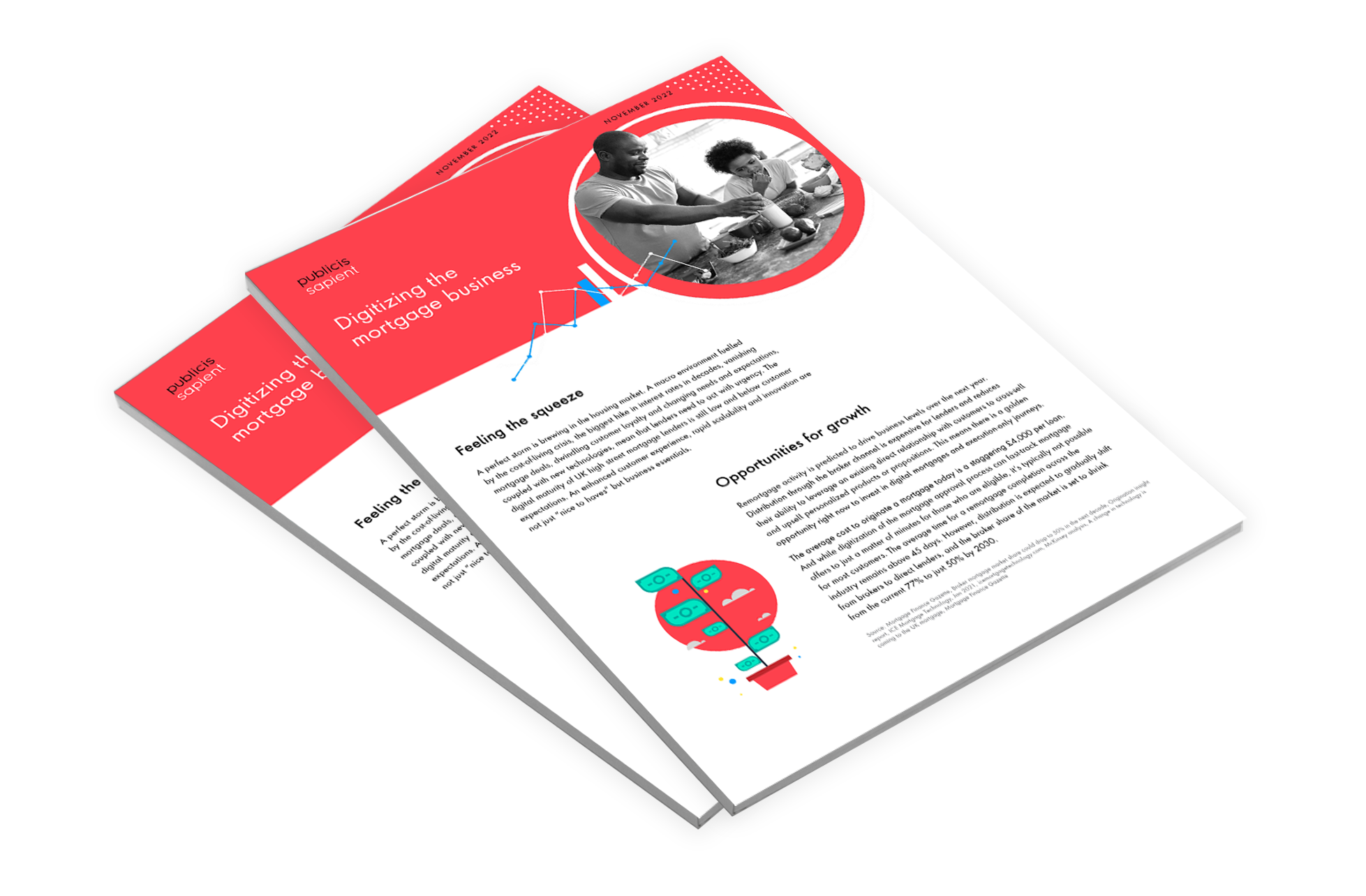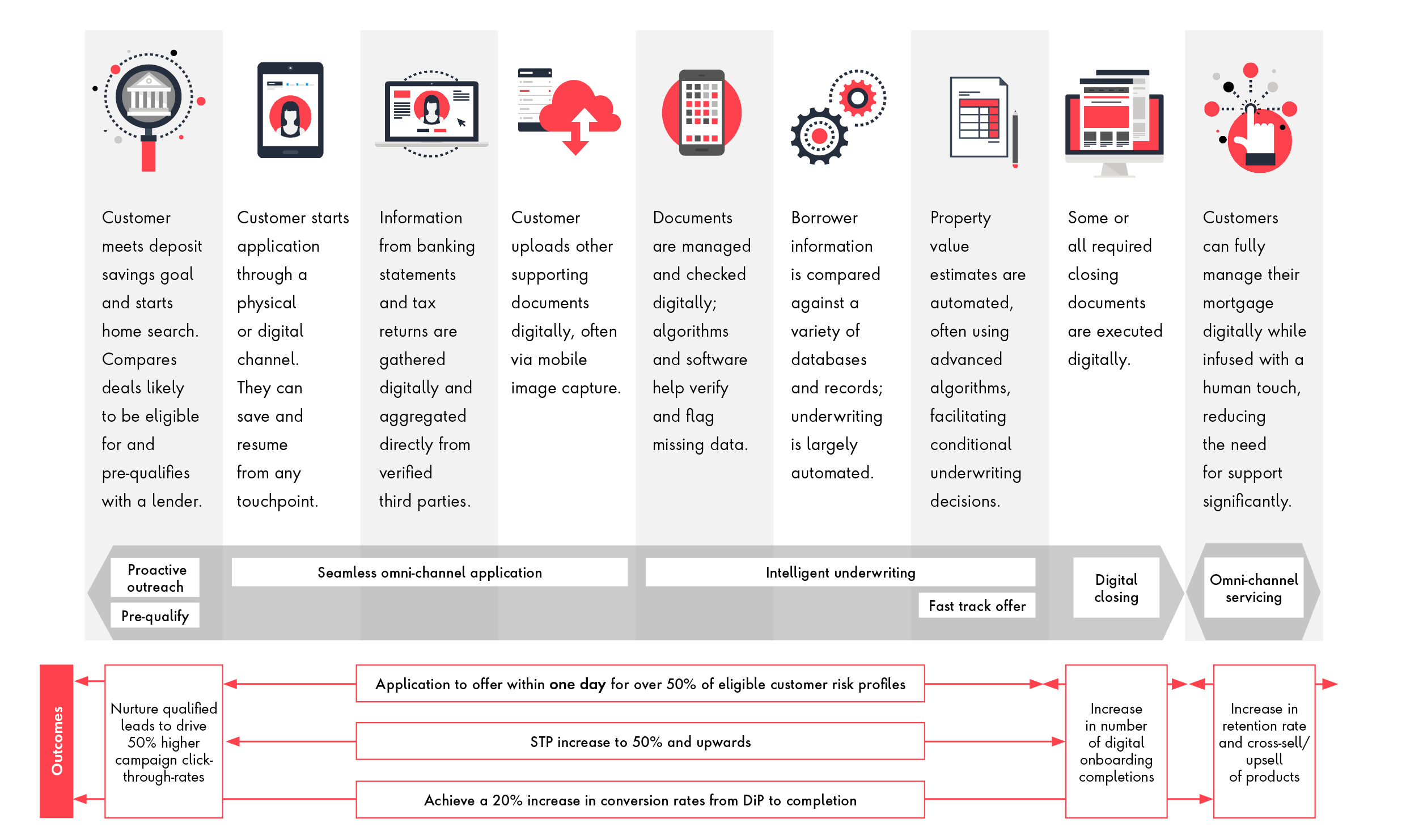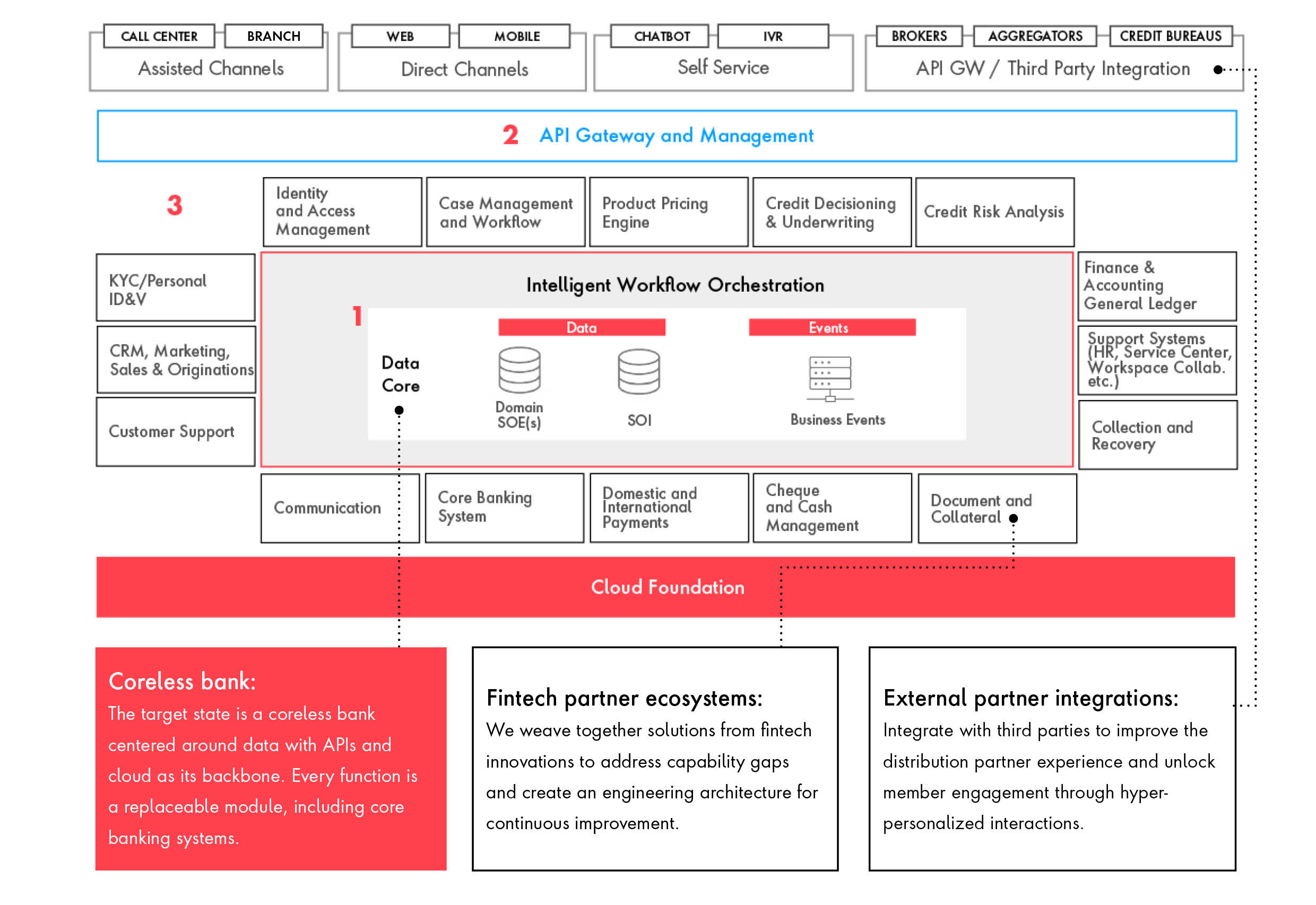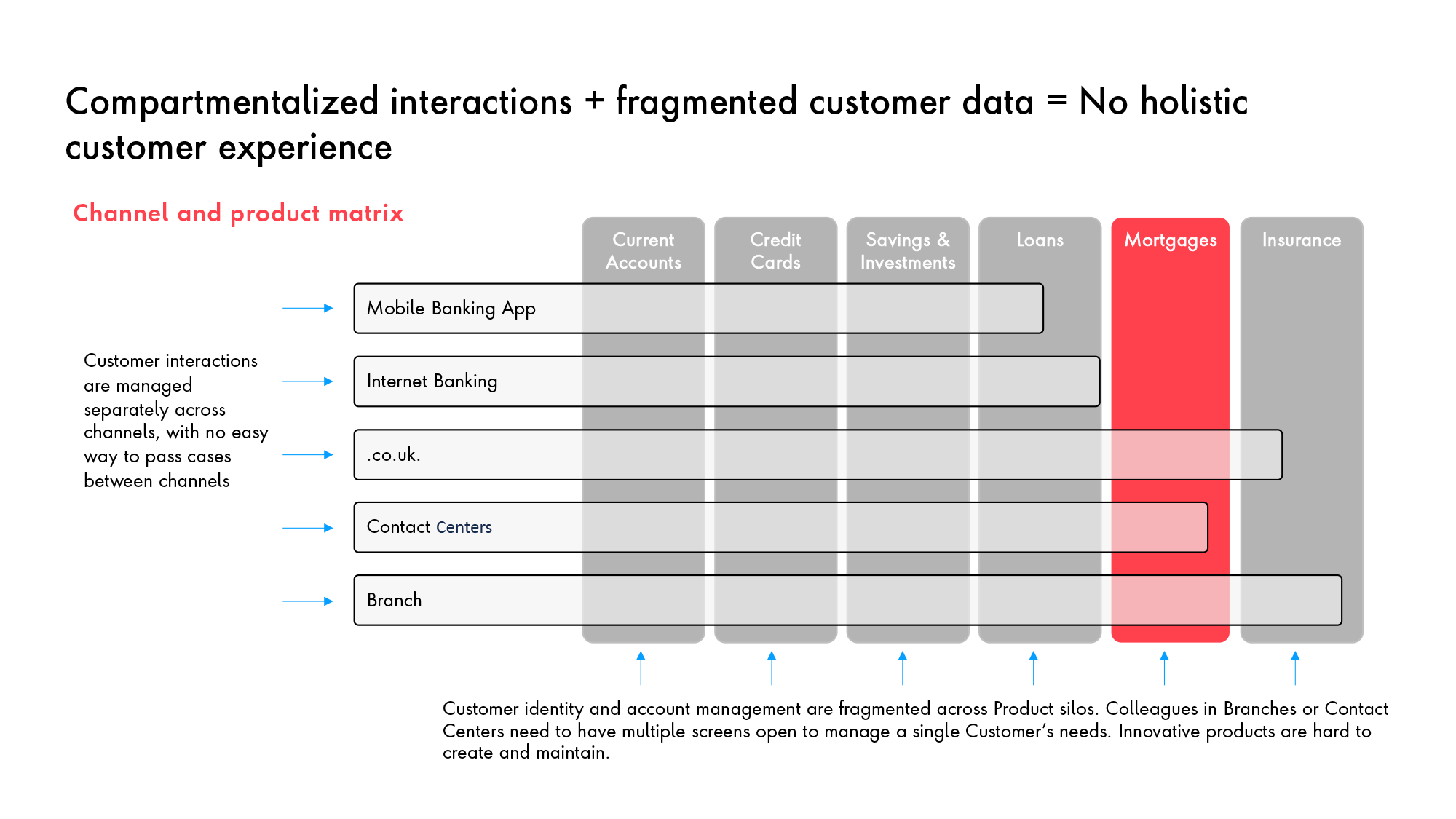What issue can we solve for you?
Type in your prompt above or try one of these suggestions
Suggested Prompt



Empowering the Mortgage Borrower
The process of buying a home can be very complex and stressful, to the extent that people feel discouraged from moving because of it. On average, applying for a mortgage and getting an offer can take anywhere from two to four weeks due to a number of factors that can delay the approval process, such as the collapse of a property sale, customers’ creditworthiness, missing information, property valuation and property chain problems.
In addition to these external factors, mortgage applications rely on a slow and sometimes disjointed process thanks to compartmentalized operating models and the reliance on paper-based and manual processes for underwriting and credit decisioning. Lenders are taking key steps to enable digitizing the entire mortgage value chain.
A transformation that shapes a single integrated digital thread to drive data across the front and back office can then help to simplify and streamline the process of securing a mortgage, which, in turn, will empower the mortgage borrower. However, there are a number of challenges that financial institutions must overcome in their journey to modernize and revolutionize the mortgage market.
Mortgage industry insights: The case for truly connected experiences
Taking the U.K. as an example, there is a huge market for the mortgage business with a staggering £1.6 trillion in outstanding residential mortgage loans (FCA, Q2 2022) where over £300 billion in mortgage advances were made in 2021, the highest since 2014.
However, we see a market that is rapidly changing. Customer loyalty, for example, is dwindling despite the top 10 U.K. mortgage lenders accounting for 84% of the market.
One of the causes of reduced customer loyalty is the strong competition between rival financial institutions. Both traditional and challenger banks are competing for customer attention, which contributes to better deals for borrowers and drives personalized choice at speed for those seeking a mortgage.
We continue to anticipate changes in the market. Given the global volatility in interest rates, mortgage rates will inevitably fluctuate over time, with higher interest bringing about a cooling of the new mortgage market and driving focus on remortgage activity instead.
Sources: Publicis Sapient Research, Statista 2022
Opportunities for growth
While remortgage activity is predicted to drive business over the next year, bank operating models will continue to struggle with high costs and long cycles.
For instance, the average timeline to close a mortgage is around 45 days, and the average origination cost is £4,000 per loan.
Moreover, distribution through the broker channel can be expensive for lenders, with 0.35% being a typical broker commission or procuration fee on a full loan size.
As financial institutions harness data intelligence and technology to target customers directly, broker distribution share is expected to gradually shrink from 77% to 50% by 2030. Lenders should choose to do more business with brokers that provide the most value and select them as strategic partners to scale cost-effectively. Brokers can set themselves apart by proactively offering concierge services, delivering personalized propositions and making customer relationships a top priority.
Furthermore, by supporting brokers to utilize broker tech through API integrations with broker aggregator platforms, lenders can help to improve broker productivity and meet customer expectations.
More importantly, there is an opportunity to invest in digital mortgages where, with an enhanced focus on direct distribution, lenders can fast-track offers for eligible customers in a matter of minutes. For greater impact, existing direct relationships with customers can be leveraged to proactively cross-sell and upsell personalized products and propositions by prequalifying eligible target segments intelligently. With the use of data and technology, lenders will then be able to drum up significant direct business and retention on an execution-only basis and empower the borrower.
Sources: Mortgage Finance Gazette, Broker mortgage market share could drop to 50% in the next decade, How much does a mortgage broker charge?, Origination insight report, ICE Mortgage Technology, McKinsey analysis, A change in technology is coming to the UK mortgage


For greater impact, existing direct relationships with customers can be leveraged to proactively cross-sell and upsell personalized products and propositions by prequalifying eligible target segments intelligently.
Emerging fintech trends are shifting borrower expectations
Fintechs and challenger banks are now joining the fight for growth and market position by offering superior customer experiences and have influenced traditional institutions to move faster toward adopting digital technology.
For example, the U.S.-based mortgage company, Better, has achieved end-to-end digitization of its entire mortgage process, eliminated fees and improved its overall customer experience. As it expanded into new markets and product lines, Better proceeded to acquire U.K.-based companies Trussle and Property Partner in 2021. The lender now offers customers a 24/7 service through technology and on-demand human assistance. Meanwhile, challenger Starling Bank has acquired the buy-to-let specialist, Fleet Mortgages, to provide mortgage lending offerings as part of their wider plan to expand their lending business substantially through M&A.
Research by Publicis Sapient has established that 30% of applicants find the mortgage process stressful, complicated and, most importantly, too long. An exceptional customer experience is a key priority and almost as critical as getting the “best rate.” In fact, it can be the differentiator that determines how people choose a mortgage provider and whether they renew or not with the same lender.
Natasa Kyprianidou , Senior Director, Product Management, Publicis Sapient
The competitive advantage is the ability to provide “speedy remortgages” that can shorten the time it takes to secure a remortgage. This will also rival product switches for customers seeking the best deal on a tight deadline.
The combination of customer demand for better experiences and shrinking margins will impact all lenders, making technology and workflow automation vital for profitability. Lenders looking to remain profitable and appeal to customers will need to embrace technology in order to process increasing numbers of requests with efficiency, speed and accuracy.
Looking toward 2023 objectives, lenders should aim to strengthen their business with stronger processes and increased efficiency by implementing leading technology.
Sources: Publicis Sapient Research, Non-advised product transfers continue to rise: UK Finance, Fintech Land Gorilla, Digital Mortgage Trends, Reshaping the UK digital mortgage experience, Finextra: Starling Bank acquires Fleet Mortgages for £50 million, Fintech Futures: Better acquires UK digital mortgage broker Trussle

Download your guide to mortgage digitization
Get the guide or (request a call back from one of our experts) to discover how to create faster, more streamlined digital mortgage experiences
Responsible lending
While banks would ideally like to be financially inclusive to every customer, they must ensure they are responsible lenders. Banks can ensure that they are responsibly lending by providing customers with a number of financial wellness tools for smarter decisioning that can help them to become “mortgage ready” and more financially secure.
Banks may consider providing credit scoring propositions to ensure that their customers are on the right track and getting the help they need to improve their creditworthiness.
By helping customers gain financial control over their own money, customers are more likely to stay engaged; as more customers are retained, they are more likely to discover a wider range of products that suit their current needs—leading to more sales. To further increase conversion rates, lenders can consider proactively pre-qualifying customers when they meet the basic requirements for a mortgage; additionally, lenders could also fast-track eligible applicants for automated underwriting.
Sources: Publicis Sapient Research
The barriers to a successful digital mortgage transformation
Currently, the mortgage industry faces three focus areas of challenges that lenders must overcome:
1. High costs from legacy technology and processes
Most lenders spend more than 50% of annual secured funding on run costs that are associated with the tech estate and are not invested in change initiatives. Legacy technologies and processes lead to a sticky cost base and high servicing costs. Current legacy systems and processes are also a hindrance to a flexible and faster underwriting process.
2. Experience expectations are not being met
With customer interactions compartmentalized by channel and customer data fragmented by product, it’s difficult to deliver a holistic customer experience. Disjointed tech and data silos also restrict the ability to use hyper-personalization and digital marketing to target existing customers and cross-sell other products or services at the right time.
3. Low productivity from inadequate servicing and sales tools
What’s more, this disconnect impacts employee productivity and experience, leading to frustration and high process times. If front-office tools and systems are not integrated, and there’s no 360° customer view, both staff and customers can have a poor experience. Disconnected systems also limit data and analytics that can be used to drive sales and help to service support.
As shown above, most banks have a compartmentalized (and fragmented) operating model that inevitably impacts customer experience.
Sources: Publicis Sapient Research
Our vision for the future
By shifting the focus from “processes” to “truly connected experiences with the borrower at the center,” there is an opportunity to create an even simpler, highly personalized, omnichannel mortgage experience to meet changing market needs.

Sources: Publicis Sapient Research, Business Insider Intelligence, Oliver Wyman, Federal Reserve Bank of New York
The foundation to modernization is coreless
Here are the top three approaches to fit a lender’s unique transformation journey toward digital maturity:
Big-bang replacement of the core
A “big-bang” approach with monolithic upgrades every few years. Selected systems would be upgraded or replaced according to the architecture roadmap (through a ”buy or build” approach).
Lender assessment:
The current core is dated or out of support, and there is an urgent need to replace it.
This method is considered to be high risk and can take anywhere from 12-48 months to process, which could cost a bank anywhere between £100 million - £500 million (or sometimes even more).
Journey-led progressive modernization
This approach will see top customer journeys reinvented end-to-end through zero-based design (or linking organizational designs to strategic priorities).
New business logic will be built instantly as modular microservices (and selectively “hollowed out” from existing systems) with shared utilities.
Lender assessment:
The current core has support and is usable for the next five to 10 years. Using this method will result in a lower appetite for the risk of data migration than that required for a big-bang or greenfield approach.
This method is considered to be low-risk but can take three years or more to complete. However, the cost would be anywhere between £50 and £200 million.
Greenfield tech stack
The greenfield tech stack leverages cloud-native architecture. New customers will be onboarded on the new platform while existing customers will be migrated.
Lender assessment:
The greenfield tech stack requires a certain appetite for risk and a budget to experiment with a technology hedge. The speed of product innovation is prioritized over the risk of data migration challenges for legacy customers.
This method is considered to be a medium risk and can take as little as nine to 12 months. The cost would be anywhere between £50 and £100 million.
Sources: McKinsey Analysis and Publicis Sapient Research
Our recommended approach
By adopting a journey-led, progressive modernization approach, Lenders can leverage new and scalable tools that accelerate delivery times while also cutting costs. Deploying intelligent workflows, AI and automated data will reduce manual processes and risk—benefits that are also realized as lenders transition from on-premise to cloud infrastructures.
The target state is a coreless bank centered around data with APIs and the cloud as its backbone. Every function is a replaceable module, including core banking systems.
This happens in three ways
1. Harness intelligent workflows, AI, data mastery and hyper-automation
2. Hollow out the core and migrate customization to microservices
3. Reinvent core processes to achieve simplicity and unlock digital value

Our proven experience: A selected client success story
We created a new streamlined end-to-end online remortgage journey within ten months for a market-leading U.K. mortgage lender.
We have helped our clients implement data-driven solutions to automate their mortgage process. This means that the most creditworthy customers can now fast-track their remortgage application and get an offer agreed upon quickly.
Customers can buy a mortgage without advice and manage the full process online in an environment where many documents are captured and checked digitally, with manual processes significantly reduced. What’s more, through accelerated underwriting, many eligible customers have been able to get offers within 24 hours.
At Publicis Sapient, we see the challenges that banks face in modernizing and improving their technologies and processes as opportunities for future growth and resilience.
Download our PDF to learn more about our work in Digitizing the Mortgage Business, or request a call back from one of our experts.
Related Reading
-
![]()
Digitize Your Mortgage Process
Discover how to create faster, more personalized experiences for your mortgage customers.
-
![]()
Hyper-Personalized Lending
Our ‘lending acquisition as a service’ solution boosts customer acquisition through personalized marketing.
-
![]()
Lending transformed
Find out how Loan Manager is transforming customer interactions and collaboration across the lending industry. Discover more about Loan Manager.








